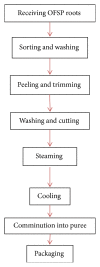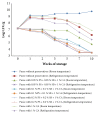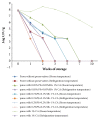Effects of Acidification and Preservatives on Microbial Growth during Storage of Orange Fleshed Sweet Potato Puree
- PMID: 29977906
- PMCID: PMC6011086
- DOI: 10.1155/2018/8410747
Effects of Acidification and Preservatives on Microbial Growth during Storage of Orange Fleshed Sweet Potato Puree
Abstract
Orange Fleshed Sweet Potato (OFSP) puree, a versatile food ingredient, is highly perishable limiting its use in resource constrained environments. It is therefore important to develop shelf-stable puree. A challenge test study was carried out to determine the effect of combinations of chemical preservatives and acidification on microbial growth in stored puree. Puree was prepared and treated as follows: control (A); 0.05% potassium sorbate+0.05% sodium benzoate+1% citric acid (B); 0.1% potassium sorbate+0.1% sodium benzoate+1% citric acid (C); 0.2% potassium sorbate+0.2% sodium benzoate+1% citric acid (D); 1% citric acid (E). Samples were inoculated with Escherichia coli and Staphylococcus aureus at levels of 5.2 x 109 cfu/100g and 1.5 x 109 cfu/100g, respectively, before being evaluated during storage for 10 weeks at prevailing ambient temperature (15-25°C) and refrigeration temperature (4°C). Total aerobic counts, yeasts, and molds were also evaluated. E. coli and S. aureus counts declined significantly (p<0.05) by 4 log cycles in all puree treatments except for control and puree with only citric acid. Total viable count, yeasts, and molds were completely inhibited except for puree with only citric acid. Combination of chemical preservatives and acidification is effective in inhibiting pathogens and spoilage microorganisms in sweet potato puree.
Figures






Similar articles
-
Microbial growth and the effects of mild acidification and preservatives in refrigerated sweet potato puree.J Food Prot. 2008 Mar;71(3):639-42. doi: 10.4315/0362-028x-71.3.639. J Food Prot. 2008. PMID: 18389715
-
Good Manufacturing Practices and Microbial Contamination Sources in Orange Fleshed Sweet Potato Puree Processing Plant in Kenya.Int J Food Sci. 2018 Apr 2;2018:4093161. doi: 10.1155/2018/4093161. eCollection 2018. Int J Food Sci. 2018. PMID: 29808161 Free PMC article.
-
Effect of Orange-Fleshed Sweet Potato Purée and Wheat Flour Blends on β-Carotene, Selected Physicochemical and Microbiological Properties of Bread.Foods. 2022 Apr 6;11(7):1051. doi: 10.3390/foods11071051. Foods. 2022. PMID: 35407138 Free PMC article.
-
The physiochemical properties and shelf-life of orange-fleshed sweet potato puree composite bread.Food Sci Nutr. 2018 Jul 11;6(6):1555-1563. doi: 10.1002/fsn3.710. eCollection 2018 Sep. Food Sci Nutr. 2018. PMID: 30258598 Free PMC article.
-
Incorporation of preservatives in polylactic acid films for inactivating Escherichia coli O157:H7 and extending microbiological shelf life of strawberry puree.J Food Prot. 2010 May;73(5):812-8. doi: 10.4315/0362-028x-73.5.812. J Food Prot. 2010. PMID: 20501030
Cited by
-
Fermented Gluten-Free Multi-Grain Cereal Paste Development: The Role of the Orange-Fleshed Sweet Potato (OFSP) as a Dietary Supplement.Nutr Metab Insights. 2023 Mar 15;16:11786388231155007. doi: 10.1177/11786388231155007. eCollection 2023. Nutr Metab Insights. 2023. PMID: 36937079 Free PMC article.
-
Isolation and Characterization of Two Lytic Bacteriophages Infecting a Multi-Drug Resistant Salmonella Typhimurium and Their Efficacy to Combat Salmonellosis in Ready-to-Use Foods.Microorganisms. 2021 Feb 18;9(2):423. doi: 10.3390/microorganisms9020423. Microorganisms. 2021. PMID: 33670722 Free PMC article.
-
Antimicrobial, sealable and biodegradable packaging to maintain the quality of shredded carrots and pineapple juice during storage.J Food Sci Technol. 2022 Aug;59(8):3139-3149. doi: 10.1007/s13197-022-05435-y. Epub 2022 Apr 9. J Food Sci Technol. 2022. PMID: 35872716 Free PMC article.
-
Application of a novel lytic Jerseyvirus phage LPSent1 for the biological control of the multidrug-resistant Salmonella Enteritidis in foods.Front Microbiol. 2023 Apr 5;14:1135806. doi: 10.3389/fmicb.2023.1135806. eCollection 2023. Front Microbiol. 2023. PMID: 37089535 Free PMC article.
-
A comparative study on the antifungal effect of potassium sorbate, chitosan, and nano-chitosan against Rhodotorula mucilaginosa and Candida albicans in skim milk acid-coagulated (Karish) cheese.Vet World. 2023 Sep;16(9):1991-2001. doi: 10.14202/vetworld.2023.1991-2001. Epub 2023 Sep 23. Vet World. 2023. PMID: 37859954 Free PMC article.
References
-
- Wheatley C., Loechl C. Acritical review of sweetpotato processing research conducted by CIP and partners in Sub-Saharan Africa. Social Sciences Working Paper Series. 2008;2008:p. 48.
-
- Fetuga G. O., Tomlins K., Bechoff A., Henshaw F. O., Idowu M. A., Westby A. A survey of traditional processing of sweet potato flour for amala, consumption pattern of sweet potato amala and awareness of orange-fleshed sweet potato (OFSP) in South West Nigeria. Journal of Food, Agriculture and Environment (JFAE) 2013;11(3-4):67–71.
-
- Saltzman A., Birol E., Bouis H. E., et al. Biofortification: Progress toward a more nourishing future. Global Food Security. 2013;2(1):9–17. doi: 10.1016/j.gfs.2012.12.003. - DOI
-
- World Health Organization. Global prevalence of vitamin A deficiency in populations at risk 1995-2005. WHO global database on vitamin A deficiency; 2009.
-
- Low J., Ball A., van Jaarsveld P. J., Namutebi A., Faber M., Grant F. K. Assessing Nutritional Value And Changing Behaviours regarding Orange-Fleshed Sweetpotato Use in Sub-Saharan Africa. Africa Transforming value Chains for food and Nutrition Security; 2015.
LinkOut - more resources
Full Text Sources
Other Literature Sources

